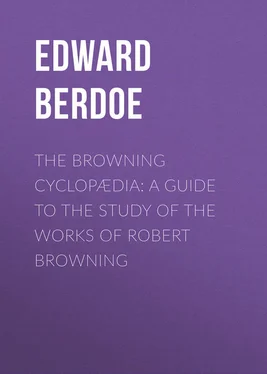Edward Berdoe - The Browning Cyclopædia - A Guide to the Study of the Works of Robert Browning
Здесь есть возможность читать онлайн «Edward Berdoe - The Browning Cyclopædia - A Guide to the Study of the Works of Robert Browning» — ознакомительный отрывок электронной книги совершенно бесплатно, а после прочтения отрывка купить полную версию. В некоторых случаях можно слушать аудио, скачать через торрент в формате fb2 и присутствует краткое содержание. ISBN: , Жанр: foreign_antique, foreign_prose, на английском языке. Описание произведения, (предисловие) а так же отзывы посетителей доступны на портале библиотеки ЛибКат.
- Название:The Browning Cyclopædia: A Guide to the Study of the Works of Robert Browning
- Автор:
- Жанр:
- Год:неизвестен
- ISBN:http://www.gutenberg.org/ebooks/36734
- Рейтинг книги:4 / 5. Голосов: 1
-
Избранное:Добавить в избранное
- Отзывы:
-
Ваша оценка:
- 80
- 1
- 2
- 3
- 4
- 5
The Browning Cyclopædia: A Guide to the Study of the Works of Robert Browning: краткое содержание, описание и аннотация
Предлагаем к чтению аннотацию, описание, краткое содержание или предисловие (зависит от того, что написал сам автор книги «The Browning Cyclopædia: A Guide to the Study of the Works of Robert Browning»). Если вы не нашли необходимую информацию о книге — напишите в комментариях, мы постараемся отыскать её.
The Browning Cyclopædia: A Guide to the Study of the Works of Robert Browning — читать онлайн ознакомительный отрывок
Ниже представлен текст книги, разбитый по страницам. Система сохранения места последней прочитанной страницы, позволяет с удобством читать онлайн бесплатно книгу «The Browning Cyclopædia: A Guide to the Study of the Works of Robert Browning», без необходимости каждый раз заново искать на чём Вы остановились. Поставьте закладку, и сможете в любой момент перейти на страницу, на которой закончили чтение.
Интервал:
Закладка:
Arezzo.A city of Tuscany, the residence of Count Guido Franceschini, the husband of Pompilia and her murderer. It is now a clean, well-built, well-paved, and flourishing town of ten thousand inhabitants. It is celebrated in connection with many remarkable men, as Mæcenas, Guido the musician, Guittone the poet, Cesalpini the botanist, Vasari, the author of the “Lives of the Painters,” and many others. ( The Ring and the Book. )
Art Poems.The great poems dealing with painting are “Fra Lippo Lippi,” “Andrea del Sarto,” “Old Pictures in Florence,” “Pictor Ignotus,” and “The Guardian Angel.”
Artemis Prologizes.( Dramatic Lyrics , in Bells and Pomegranates , No. III. 1842.) Theseus became enamoured of Hippolyta when he attended Hercules in his expedition against the Amazons. Before she accepted him as her lover, he had to vanquish her in single combat, which difficult and dangerous task he accomplished. She accompanied him to Athens, and bore him a son, Hippolytus. The young prince excelled in every manly virtue, but he was averse to the female sex, and grievously offended Venus by neglecting her and devoting himself entirely to the worship of Diana, called by the Greeks Artemis. Venus was enraged, and determined to ruin him. Hippolyta in process of time died, and Theseus married Phædra, the daughter of Minos, the king of Crete. Unhappily, as soon as Phædra saw the young and accomplished Hippolytus, she conceived for him a guilty passion – which, however, she did her utmost to conceal. It was Venus who inspired her with this insane love, out of revenge to Hippolytus, whom she intended to ruin by this means. Phædra’s nurse discovered the secret, and told it to the youth, notwithstanding the commands of her mistress to conceal it. The chaste young man was horrified at the declaration, and indignantly resented it. The disgraced and betrayed Phædra determined to take her own life; but dying with a letter in her hand which accused Hippolytus of attempts upon her virtue, the angry father, without asking his son for explanations, banished him from the kingdom, having first claimed the performance from Neptune of his promise to grant three of his requests. As Hippolytus fled from Athens, his horses were terrified by a sea monster sent on shore by Neptune. The frightened horses upset the chariot, and the young man was dragged over rocks and precipices and mangled by the wheels of his chariot. In the tragedy, as left by Euripides, Diana appears by the young man’s dying bed and comforts him, telling him also that to perish thus was his fate: —
“But now
Farewell: to see the dying or the dead
Is not permitted me: it would pollute
Mine eyes; and thou art near this fatal ill.”
The tragedy ends with the dying words of Hippolytus: —
“No longer I retain my strength: I die;
But veil my face, now veil it with my vests.”
So far Euripides. Mr. Browning, however, carries the idea further, and makes Diana try to save the life of her worshipper, by handing him over to the care of Æsculapius, to restore to life and health by the wisest pharmacies of the god of healing. Mr. Browning’s poem closes with the chaste goddess watching and waiting for the result of the attempt to save his life. The poet has adopted the Greek spelling in place of that to which we are more accustomed. The Greek names require their Latin equivalents for non-classical scholars. Artemis is the Greek name for Diana ; Asclepios is Æsculapius ; Aphrodite , the Greek name of Venus ; Poseidon is Neptune ; and Phoibus or Phœbus is Apollo , the Sun. Heré == Hera or Juno, Queen of Heaven. Athenai == Minerva. Phaidra , daughter of Minos and Pasiphae, who married Theseus. Theseus , king of Athens. Hippolutos , son of Theseus and Hippolyte. Henetian horses , or Enetian , of a district near Paphlagonia.
Artemisia Genteleschi(Beatrice Signorini, Asolando ), “the consummate Artemisia” of the poem, was a celebrated artist (1590-1642). See Beatrice Signorini.
“Ask not the least word of praise,”the first line of the lyric at the end of “A Pillar at Sebzevah,” No. 11 of Ferishtah’s Fancies .
Asolando: Fancies and Facts.Published in London, December 12th, 1889, on the day on which Mr. Browning died in Venice. Contents : Prologue; Rosny; Dubiety; Now; Humility; Poetics; Summum Bonum; A Pearl, A Girl; Speculative; White Witchcraft; Bad Dreams, I., II., III., IV.; Inapprehensiveness; Which? The Cardinal and the Dog; The Pope and the Net; The Bean-Feast; Muckle-mouth Meg; Arcades Ambo; The Lady and the Painter; Ponte dell’ Angelo, Venice; Beatrice Signorini; Flute Music, with an Accompaniment; “Imperante Augusto, Natus est – ”; Development; Rephan; Reverie; Epilogue. The volume is dedicated to the poet’s friend, Mrs. Arthur Bronson. In the dedication the poet explains the title Asolando: it was a “ title-name popularly ascribed to the inventiveness of the ancient secretary of Queen Cornaro, whose palace-tower still overlooks us .” Asolare – “to disport in the open air, amuse oneself at random.” “The objection that such a word nowhere occurs in the works of the Cardinal is hardly important. Bembo was too thorough a purist to conserve in print a term which in talk he might possibly toy with; but the word is more likely derived from a Spanish source. I use it for love of the place, and in requital of your pleasant assurance that an early poem of mine first attracted you thither; where and elsewhere, at La Mura as Cà Alvisi, may all happiness attend you! – Gratefully and affectionately yours, R. B.” – Asolo, Oct. 5th, 1889 .
Asolo( Pippa Passes – Sordello – Asolando ), the ancient Acelum: a very picturesque mediæval fortified town, in the province of Treviso, in Venetia, Italy, 5500 inhabitants, at the foot of a hill surmounted by the ruins of a castle, from which one of the most extensive panoramas of the great plain of the Brenta and the Piave, with the encircling Alps, and the distant insulated group of the Euganean hills, opens before the traveller. On a fine summer evening the two silver lines of the Piave and the Brenta may be followed from their Alpine valleys to the sea, in the midst of the green alluvial plain in which Treviso, Vicenza and Padua are easily recognised. Venice, with its cupolas and steeples, is seen near the extreme east horizon, which is terminated by the blue line of the Adriatic; whilst behind, to the north, the snow-capped peaks of the Alps rise in majestic grandeur. The village of Asolo is surrounded by a wall with mediæval turrets, and several of its houses present curiously sculptured façades. – The castle, a quadrangular building with a high tower, is an interesting monument of the thirteenth century. It was the residence of the beautiful Caterina Cornaro, the last queen of Cyprus, after the forced resignation of her kingdom to the Venetians in 1489. Here this lady of elegant tastes and refined education closed her days in comparative obscurity, in the enjoyment of an empty title and a splendid income, and surrounded by a small court and several literary characters. Of these, one of the most celebrated was Pietro Bembo, the historian of Venice, afterwards Cardinal, whose celebrated philosophical dialogues on the nature of love, the Asolani , have derived their name from this locality. Mr. Browning visited Asolo first when a young man; it was here that he gathered ideas for Pippa Passes and Sordello , and in the last year of his life his loving footsteps found their way to the little hill-town of that Italy whose name was graven on his heart. Here, as Mr. Sharp reminds us in his Life of Browning , the poet heard again the echo of Pippa’s song —
Читать дальшеИнтервал:
Закладка:
Похожие книги на «The Browning Cyclopædia: A Guide to the Study of the Works of Robert Browning»
Представляем Вашему вниманию похожие книги на «The Browning Cyclopædia: A Guide to the Study of the Works of Robert Browning» списком для выбора. Мы отобрали схожую по названию и смыслу литературу в надежде предоставить читателям больше вариантов отыскать новые, интересные, ещё непрочитанные произведения.
Обсуждение, отзывы о книге «The Browning Cyclopædia: A Guide to the Study of the Works of Robert Browning» и просто собственные мнения читателей. Оставьте ваши комментарии, напишите, что Вы думаете о произведении, его смысле или главных героях. Укажите что конкретно понравилось, а что нет, и почему Вы так считаете.












